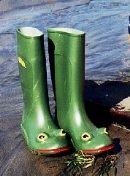
I taught Winnie-the-Pooh today for the first time ever. I hit the jackpot with students for my summer teaching premiere; they are beyond fabulous. they even laugh at my dumb jokey comments!
I admit: I put Pooh on the syllabus because I thought it might be nice to dovetail at least ONE teaching text with my material culture/toys project.
Today, naturally, we didn't have time to get to everything, because we were churning over Ursula LeGuin's "From Elfland to Poughkeepsie" for the first chunk of class.
But all my students reported a similar experience: reading Pooh, you forget that these are stuffed animals. toys. Pooh reports pain and discomfort in the first chapter (when he goes after the bees and their honey), but only a few pages later, Eeyore evidently painlessly submits to having his tail hammered back in place. This is a bit odd. Is it a failure of internal consistency? how do we understand the inhabitants of the Forest as toys, dolls, stuffed friends? does it MATTER that they are stuffed animals? Their toyness seems most important in the way it gives Christopher Robin total dominance over them.
Other Pooh notes:
- Eeyore gets all the best lines. When read aloud, in a very sarcastic quasi-deadpan voice, Eeyore's lines were HYSTERICAL.
- The eternal question - "IS PIGLET A GIRL?" - was raised by the group discussing gender in the text. (for what it's worth, Piglet is not a girl. He may, however, be a transpig. it's hard to tell).
- Winnie-the-Pooh may be a fantasy text, but it is NOT an animal story
- All the characters LOOK like stuffed animals in their illustrations, except Rabbit and Owl. Interestingly, Rabbit and Owl are the only two characters to not have their basis in real-life toys belonging to Christopher Robin (Billy Moon) Milne. Instead, Rabbit and Owl are entirely the creation of A.A. Milne.
- This may account for their....grown-up-ishness.
- "In Which Kanga and Roo Come to the Forest, and Piglet Has a Bath" is hands down the funniest chapter in the book.
- Rabbit gets a great line in this chapter, which had me snortling throughout class: "Suppose I my family about with me in my pocket, how many pockets should I want? ... that's eighteen. Eighteen pockets in one suit! I haven't time" (88). (my italics).
- I love the idea of not having time for eighteen pockets. I know EXACTLY what Rabbit means here.
- Owl is a terrible speller, though his words are strangely impressive and long.
On Thursday, I teach The Lion, the Witch and The Wardrobe, and I am flat-out terrified! I've never taught it before, and I'm not sure how I want to handle it. I have a call out to my friend the medievalist/religionist/general genius to see if he'd be willing to do a bit of guest lecturing. I want to think about: nature/natural world (I remember an interesting discussion about this book way back at Georgetown, where someone pointed out Edmund's resistance to the natural world as a marker of his "badness"); family; religion (obviously). I think gender is always good to think about, and perhaps in this text more than others, masculinity seems central.
but what else can I say?
I'm not a lewis expert! Once we get past Charlotte's Web I'll be sturdier on my teaching feet; all the other texts I've chosen are ones I've either really thought about extensively, or ones I've thought about even MORE extensively because I'm studied and/or written about them.
But the richness of today's Pooh discussion was an absolute joy. There was strong positive feeling for the book, and a real eagerness and willingness to dive right in and engage in critical conversation about the text.




1 comment:
I will probably never be able to forget the term "transpig." That is beautiful!
Post a Comment